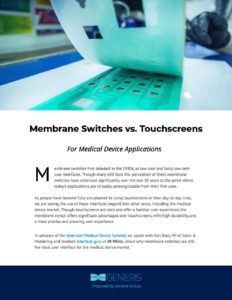Membrane switches first debuted in the 1980s, as low-cost and fairly low-tech user interfaces. Though many still hold this perception of them, membrane switches have advanced significantly over the last 30 years to the point where today’s applications are virtually unrecognizable from their first uses.
As people have become fully accustomed to using touchscreens in their day-to-day lives, we are seeing the use of these interfaces expand into other areas, including the medical device market. Though touchscreens are slick and offer a familiar user experience, the membrane switch offers significant advantages over touchscreens, with high durability, and a more precise and pleasing user experience.
In advance of the American Medical Device Summit, we spoke with Ken Boss, resident interface guru at JN White, about why membrane switches are still the ideal user interface for the medical device market.
What are the key benefits of membrane switches for medical devices and how do touchscreens compare on these benefits?
Durability – Durability is definitely one of the major benefits. Membrane switches last a long time and can handle a high number of actuations (or ‘pushes’). Another related, but more specific, benefit is that because membrane switches are very easy to seal, they can be wiped down and cleaned frequently, as hospital and medical clinic procedures require. Touchscreens can certainly be sealed, and they can be very durable, although the top layer is often glass, which means they are more destructible than a membrane switch.
User Experience – With a touchscreen you really need a visual, haptic, or audio feedback to know that you’ve actually engaged a button or command. With a membrane switch, you have more of a tactile experience which allows for higher precision and peace of mind. They provide a really nice user experience – when you push a button to dispense meds, or for IV therapy, knowing that you’ve pushed the right button and receiving the right feedback is critical. This is even more true in medical situations, where practitioners wear gloves on a regular basis. The tactile feedback is very important.
Designability – Lastly, membrane switches have a much thinner profile which is much easier for mechanical designers to work with when creating medical devices. Touchscreens can be more difficult to integrate into an entire medical product assembly because of their overall thickness.
Click through to read the full interview with Ken Boss.

%20(1).png?width=773&height=112&name=Generis%20Logo%20full%20Colour%20(Large)%20(1).png)


-Nov-13-2025-01-18-02-9699-PM.png)
-2.png)